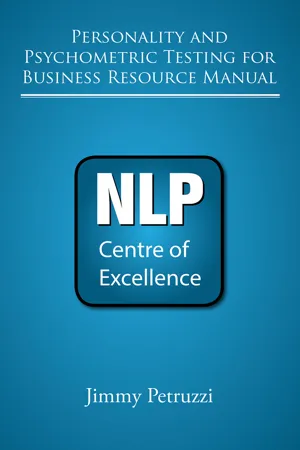
- English
- ePUB (mobile friendly)
- Available on iOS & Android
Personality and Psychometric Testing In Business Resource Manual
About This Book
Personality and Psychometric testing in business Learning Resource Manual: by Jimmy Petruzzi is widely recognised as being one of the leading practical resources on psychometric and personality testing for business. The resource manual sheds light on the importance of using psychometric and personality tests in the field of business, providing employers potentially a better way of recruiting and ensuring that potential employees are suitable for certain positions. It also includes real life examples that can be used to measure the effectiveness of psychometric and personality tests in order to analyse and evaluate the capability and personality of candidates.
In this resource manual, you will find valuable information regarding various personal assessment instruments. There are sample tests based on various personality assessment models to help you understand the kind of questions that are asked in such personality tests and the elements they aim to explore of a candidate's personality and capabilities.
In addition to that, the importance, benefits and limitations of such testing in the workplace has been explained point by point for your information. This guide will help you know more about workplace testing and its various elements.
Frequently asked questions
Information
Table of contents
- Personality and Psychometric Testing In Business Resource Manual
- Title
- Disclaimer
- TOC
- Executive Summary
- Introduction
- What is a Personality Test?
- What is a Psychological Test?
- Personality – An Insight
- What do these Tests Measure?
- Importance of Personality and Psychometric Testing in Business
- Characteristics of Personality and Psychometric Tests
- Types of Psychometric Tests
- Why are these Tests Used in Business?
- Use of Personality and Psychometric Testing in Business
- Types of Personalities in the Workplace
- Correct Usage of Psychometric and Personality Testing in the Workplace
- Legal Aspect of Psychometric and Personality Testing in the Workplace
- Types of Personality Test Models
- Benefits of Personality and Psychometric Testing
- Limitations of Personality and Psychometric Testing
- Conclusion